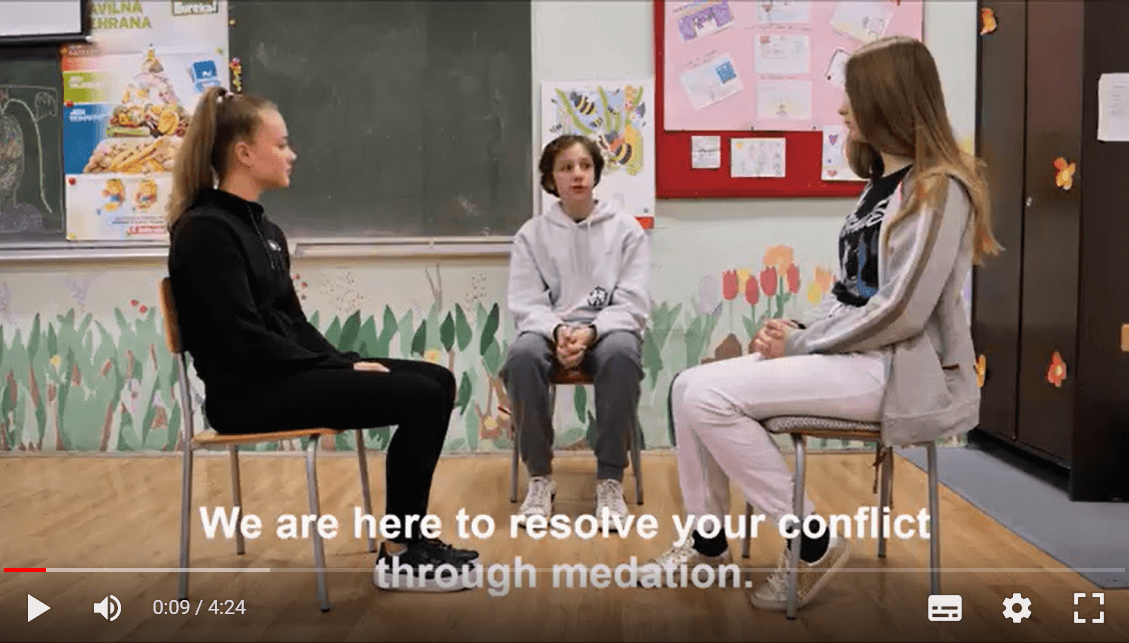A JOURNEY THROUGH EDUCATIONAL MANAGE OF QUARRELS AT SCHOOL (PART 3 OF 3)
By Natalija Havelka and Tanja Jakovac
School Ivana Goran Kovačić in Vrbovsko (Croatia) – partner of “Argue at school” Erasmus+ Consortium – have been implementing Peer Mediation for more than ten years. School’s teachers were trained in 2009, and since then they have been regularly implementing it.
This method philosophy and methodology was influenced by Adam Curle and Nonviolent Communication by M. Rosenberg and others scholar.
Peer Mediation will benefit students, teachers and parents in changing the attitudes and beliefs about managing conflict.
We still usually face traditional beliefs that conflicts should be resolved with penalties; instead, teachers must learn that conflicts are part of everyday life and can be solved without punishing students.
How does Peer mediation works
Involves 2 students and 1 mediator. The method is based on the mediator’s neutrality: this contributes to the feeling of appreciation and active listening for both sides involved in the quarrel; they learn strengthening self-awareness, empathizing with each other, and developing awareness of individual and collective responsibility.
There are five steps in the method, necessary to develop this approach: define the rules; describe the situation of conflict; ask each other questions and define positions; offer a possible solution; make an agreement on the solution that is acceptable for both sides.
Do you need help? Ask for a mediator
In this model, students are informed where and when they can ask for a mediator. Teachers have an introduction to mediation and when their students need help, they refer them to mediators, instead being a “judge” in the conflict.
Children and their headteacher choose with an anonymous questionnaire several of their classmates who they would trust to talk to in a situation of conflict, and these get the opportunity to become mediators. The selected future mediators, and at least two teachers, meet once a week and learn mediation skills.
In this way entire classes of students learn about conflict, feelings and needs, having an introduction to mediation and practice some conflict resolution skills.
A space and a time to confront each other
Mostly the mediation session is organized in a room reserved only for the Mediation Club, that has posters with communication guidelines and mediation steps, papers, code of ethics for mediators.
Mediators will not suggest to you what to do or say, they will just help you talk in a safe space, without insults, and choose a solution that you both will like.
Students get helped by peers to solve the situation with win/win result. They gain experience that solving problems in such a way is possible, and are motivated to try themselves in future conflict to listen to other parties, and try to find creative solutions.
One adult person is waiting in the next room for the case mediators should ask for help.
If mediation doesn’t lead to a solution, it is repeated twice; if this doesn’t lead to an agreement the adult decides on the conflict.
The programme of training
Can be started as early as 4th or 5th grade in primary schools. Later is not recommended (but the Programme can be easily adapted for first grade of secondary school).
The Programme developed by Center for Peace Osijek consisted of 5 full days of training. Of course the training needs to be planned with teachers who will be involved, and also pass through presentations of the program to the whole school (teachers, representatives of students and parents).
CPO’s team supports the school for at least two school years; during the second year the support is in organizing the work of the Mediation Club, connecting them with other schools who have Peer Mediation Clubs.
Children and teenagers can do it themselves
Teachers’ role is to recognize that there is a conflict: the teacher should ask them what the conflict is about and refer students to the Mediation Club.
The rule for students is that if you have a conflict that you cannot solve yourself, or would like to find help, you have to seek mediators in your Mediation Club.
Teachers are responsible for supporting mediators: should be close to them, to be able to help or advise peer mediators, if needed. They also talk to mediators after the session, about the process, feelings and needs of mediators, and celebrate successes together.
School pedagogue has also an important role. It is highly recommended that the psychologist and the school pedagogue participate in the education and the whole process.
In conclusion, Peer Mediation is a complex approach, that need a good training for mediators, teachers that lead the process, students and parents; but this effort can disseminate in the school community a different attitude to quarrels first, and to conflicts in general, based on the ability to understand behaviors and feelings one each other, and to share opinion and the search of agreement in a non-violent way.


